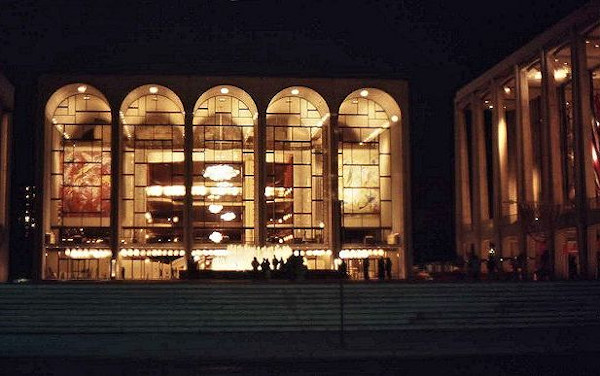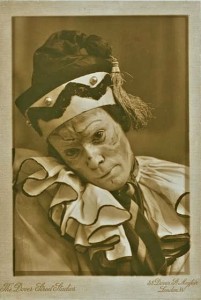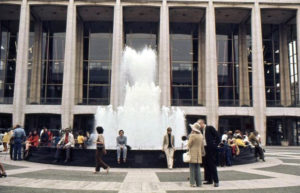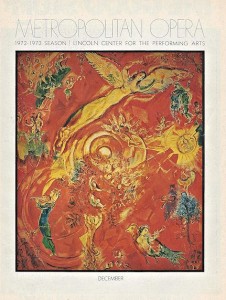Chapter 22 (Part 2) – An active year with John in New Rochelle
Theater, opera and ballet in New York City
However, that one year in New Rochelle was anything but a boring year. It was filled with theater and opera, ballet and concerts, and I will only skim off the very major events in both the drama and the music fields that we attended that year.
The most remarkable theatrical event during that year was no doubt a play by Fernando Arrabal “And They Put Handcuffs On the Flowers”, director and designer also Arrabal. It was performed at the Mercer Arts Center, Mercer Street, in Greenwich Village in the fall of 1972. This perfectly unconventional play is partly a reflection of Arrabal’s father’s experience in a Spanish prison under Franco’s regime, which Fernando Jr. could never forget. He settled in France in 1955 to be able to see Bertold Brecht’s plays and to get treatment for his tuberculosis. The title in French of his play is ‘Et ils passèrent des menottes aux fleurs’, but it was written in Spanish. It became a great success all over the western world from 1969 on.
“Le règle du jeu” writes: “‘Et ils passèrent des menottes aux fleurs’ est une œuvre atypique, une fresque apocalyptique et géniale, composée de rêves et de délires croisés de quatre prisonniers politiques, au moment où l’homme marche sur l’espace et les tyrans n’en finissent pas de mourir…” [1. ‘And they put handcuffs on the flowers’ is an atypical work, an apocalyptic and brilliant fresco, composed of the dreams and the intersecting deliriums of four political prisoners, at the time when man walks in space and tyrants never die.]
I now know that there was quite fierce opposition to the play, shocked reaction by audiences and also negative reviews in the press. However, generally speaking, it was an astounding success. John and I were spellbound. The way the public was seated all around the stage, almost mingling with the actors, immensely increased the feeling of being in the play. We were fascinated by the outspokenness of the play and the fabulous acting.
In the intermission the actors mingled with the audience as we were having tea or coffee. I went up to one of the actors who was standing by the bar looking as if he was waiting for me to come up and talk to him. I told him how enormously impressed we were. We were completely shaken by what we had seen. Probably due to my feeling of having grown up with the theater, I have never been timid about talking to actors after a show, and in this case my praise was very well received.
Arrabal was an extraordinarily prolific writer, with over a hundred plays published. Besides that, he wrote novels, essays and a huge amount of poetry. And there was his notorious “Letter to General Franco” published during the dictator’s lifetime. .
Wikipedia says: “Arrabal’s theatre is a wild, brutal, cacophonous, and joyously provocative world. It is a dramatic carnival in which the carcass of our “advance”‘ civilizations is barbecued over the spits of a permanent revolution. He is the artistic heir of Kafka’s lucidity and [Alfred] Jarry’s humor; in his violence, Arrabal is related to [Marquis de] Sade and Artaud. Yet he is doubtless the only writer to have pushed derision as far as he did. Deeply political and merrily playful, both revolutionary and bohemian, his work is the syndrome of our century of barbed wire and Gulags, a manner of finding a reprieve.”
____________________
Another major event was seeing “Petrushka” by Stravinsky in a Ballets Russes production that was nothing less than historical. Petrushka has long been one of my absolute favorite pieces of music, and as I listen to the music I see the ballet all over again, the teaming masses in a couple of scenes and Petrushka in his cell with and without the ballerina.
Iincidentally, when I first bought my sailboat, a little Rhodes 19, I wanted to name it Petrushka. However, I had second thoughts when I realized that I was going to cut out the letters myself in paper and paint the name of my boat on the stern. So almost as good was ‘Kijé’ by Sergueï Prokofiev, another piece of music that I adore. The only thing I can possibly have against Prokofiev’s “Lieutenant Kijé” is its that it is too short, and the same thing goes for his “Classical Symphony”. Those two are my favorite pieces by Prokofiev, and they are both at the top of my list of most wonderful music. So it was with great joy that I cut out the letters of Kijé (accent and all) in somewhat stiff paper, rowed my dinghy out to my boat and painted Kijé in black paint on the stern of my Rhodes 19.
In October 1972 we saw “Petrushka”, this incredibly wonderful ballet, at the City Center, by the Joffrey Ballet. The program says: Scenery and Costumes after the Originals by Alexandre Benols. The original choreography was by Michel Fokine, who had died in 1942. There is no mention of any other choreographer. [2. Petrushka was first performed by Diaghilev’s Ballets Russes in Paris in June 1911 at the Théâtre du Châtelet and this performance was supposed to be a replica of the original one in Paris by the Ballets Russes. The company split after Diaghilev’s death in 1929. One of the two competing managers founded the Ballet Russe de Monte Carlo, which became the best known branch of the Ballets Russes. It should be added too though that several American ballet companies can be considered as direct descendants of Diaghilev’s Ballets Russes. At the beginning of World War II Le Ballet Russe made its headquarters in New York City and toured a great number of the major American cities. (Descendants of the Ballets Russes)]
A friend and former colleague of mine, Madge Rosenbaum, a history teacher from Mamaroneck High School, quite a bit older than I, had one foot in France in her beautiful house in Dordogne where she spent half the year after her retirement. I was amazed when she told us that her father had taken her to Monte Carlo when she was a young girl to see the Ballets Russes. That seemed like long gone history to me. I was of course thinking right away of “Petrushka”, but I don’t remember that she ever told us which ballet she saw.
Amazingly enough, we saw virtually the same performance a few years later in Paris, in 1976, but of course now with different dancers. This time it stated in the program, more correctly, “Choréographie d’après Michel Fokine”, (inspired by Fokine), and, as in New York City, Décors et Costumes d’Alexandre Benols. However, the remarkable thing here was that Petrushka was now performed by the legendary Rudolf Nureyev with the extraordinarily beautiful and superb dancer Noëlla Pontois as the ballerina, Columbine. The most remarkable aspect of Nureyev’s performance, and no doubt of the original Ballets Russes, was the combination of theater, ballet and mime, which makes the entire ballet such an extraordinarily gripping event.
John and I also saw Tchaikovsky’s “Swan Lake” by the New York City Ballet, choreography by George Balanchine, at the City Center in June 1973. The star was the outstanding and beautiful Allegra Kent. [3. “The beloved American ballerina Allegra Kent created and danced in nearly all principal roles in George Balanchine’s celebrated oeuvre during her thirty years as a dancer with the renowned New York City Ballet. “] I am not usually a Tchaikovsky lover, but this ballet is one thing I do like by him. It’s wonderfully dramatic and it’s sheer beauty as choreographed by Balanchine. The music and the dancing melt together in a hymn to beauty.
____________________
And of course there was opera, with John being an avid opera aficionado. Two extraordinary opera events occurred that year, connected in one way, even though so different The first one was hearing my favorite tenor ever, Jon Vickers, in “Otello”, one of Verdi’s most excruciatingly moving operas. It was in December 1972 at the Met and Teresa Zylis-Gara sang Desdemona. This Polish opera soprano was entirely up to the task. Jon Vickers has a tenor voice that is not like any other tenor . His timbre is so special that I almost shiver when I hear him sing high drama. Sure, Luciano Pavarotti and Placido Domingo are wonderful tenors, but Jon Vickers is unique.
I had already seen “Otello” at Malmö Stadsteataer in a guest performance by the Royal Opera in Stockholm in the spring of 1964, with the outstanding soprano Margareta Hallin as Desdemona, and of course knowing the opera makes a great deal of difference. Margareta Hallin was, in the words of the notoriously shocking music critic Sten Broman (Sydsvenska Dagbladet) ‘the world’s best soprano’. She was, in fact, extraordinary. It is said that the only reason why she never accepted to sing at the Met was because she did not speak English. Be that as it may, Hallin was a superb Desdemona and a superb soprano generally.
A funny little incident that I will never forget occurred at the Met in the fall of ’72. We were watching an opera – it could have been Otello and Teresa Zylis-Gara. We had good seats in the center of the orchestra. At one point the soprano climbed beautifully up on a high note. It was perfection. John and I both chuckled in sheer delight. It’s a funny habit that comes naturally to both of us. A serious middle-aged lady sitting right in front of us, turned around with an irritated look and hushed us. She clearly had no inkling of what made us chuckle so happily. She might even have thought we were not paying attention to the singing. whereas, in reality, we were overcome by the beauty of it.
The second almost incredible high point in opera that year was seeing and hearing Jon Vickers (again!) in Benjamin Britten’s “Peter Grimes” in the spring of 1973, a production lent by Covent Garden. We had also seen Peter Grimes at the Met a year before. Here I was confronted with a first. I did not know “Peter Grimes”, but I knew the story and I found the performance almost unbearably gripping. I was moved to tears at the end. The sets and costumes were by Tania Moiseiwitsch and the opening scene of the opera was gorgeous, reminiscent of a painting by Rembrandt.
We saw “Peter Grimes” again a couple of years later in Paris, and again with Jon Vickers. Heavenly. I suspect that the final scenes I remember from that opera were probably more from the Paris production. Peter Grimes is going mad with grief because the young boy who goes fishing with him has drowned. Peter Grimes naturally blames himself for going out in the rough sea with the boy. In fact, I can still today hear in my head Jon Vickers’ uniquely beautiful voice when he screams in despair as he is told that the young boy had drowned. Then he gets into his boat to go and drown himself in the stormy sea. There are of course many excellent tenors who have sung Peter Grimes – Benjamin Britten’s friend, Peter Pears, above all – but I can not imagine anybody but Jon Vickers in that part. To me, Peter Grimes is Jon Vickers. With his incredibly powerful and dramatic tenor, it was heartrending.
My enormous delight at hearing Jon Vickers’ singing brings to mind my favorite mezzo soprano, Teresa Berganza.
A few years later in Paris we saw Mozart’s “The Marriage of Figaro” – “I Nozze di Figaro”, as the program says. It was in December 1974 and we were with John’s aunt and uncle Ann and Larry who were visiting Paris. Larry was as much of an opera fan as John.
Cherubino was sung by Teresa Berganza, this most extraordinary mezzo, another voice that to me is unique in its range. Her aria – well his area, since she is playing Cherubino – in the Countess’s magnificent bedroom in Act 2, ‘Voi che sapete’ was so unbelievably beautiful that to say it got a standing ovation would be an understatement. The audience went absolutely wild and we would just never stop applauding. I don’t remember one other time when I applauded so furiously that my hands actually got almost sore. [4. Teresa Berganza – Voi che sapete – “Le Nozze di Figaro“]
If someone asked me very generally who is my favorite opera singer of all – a silly question no doubt, but let’s still assume – I do believe I would say Jon Vickers. His soft and at the same time extraordinarily powerful and dramatic timbre, so perfect that it is almost unearthly, makes me feel that heaven has opened. However, if the question was, more intelligently, which male and which female singer would be my favorite, there is absolutely no doubt. The female singer would be the mezzo Teresa Berganza. I have several favorite sopranos, but Teresa Berganza is my overall favorite female voice. Her timbre, once again, is so special I find it unique.
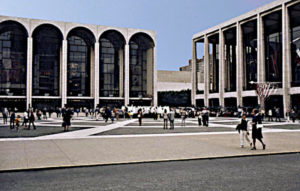
Lincoln Center; the Metropolitan Opera left and the New York Philharmonic Hall on the right; later called the Avery Fisher hall
At the Metropolitan Opera we heard another wonderful mezzo, Marilyn Horne as Carmen, in June ’73. You might find her a bit heavyset for the role, but it didn’t matter. She was as seductive as a Carmen should be and perfectly into the part — and her voice is of course perfect for the part – she was Carmen.
Joan Sutherland and Marilyn Horne were the golden duo who sang in many operas as the leading soprano and the lead mezzo. We never got to see Joan Sutherland though, but I know her voice perfectly well from numerous records — well, today they are CDs. She is definitely one of my favorite sopranos, and it only happens very rarely that she gets “marbles in her mouth”, the way it happens all too often for Maria Callas. That is an expression I have made up because that’s exactly the way it sounds to me. John seems to understand what I mean. It was something that bothered me when I heard Callas on the radio even before I knew John. Allyn and I used to listen to the Saturday afternoon direct broadcasts from the Met (brought to you by Texaco!!!) on WQXR, with an intermission talk by wonderful Milton Cross. What he didn’t know about opera was not worth knowing
However, back to “la Callas” — in later years I have heard magnificent recordings of opera by Maria Callas and, I perfectly well understand now that she got the position that she deserved among the great sopranos, next to Renata Tebaldi, who is my all-time favorite soprano. Her voice is pure heaven to me. She is la diva, meaning divine, ahead of all the other wonderful opera sopranos..
Those were the days when radio and television hadn’t yet become infested with lies and propaganda. Even political commentators were worth listening to. Eric Severeid, Walter Cronkite, (Following Cronkite’s editorial report about the war in Vietnam, President Lyndon Johnson is claimed by some to have said, “If I’ve lost Cronkite, I’ve lost Middle America.”) James Reston and, a bit later, Tom Wicker lasted well through my years in the U.S.
When I arrived in the U.S. in 1964, the presidential campaign was in full swing and I was fascinated by following up on it via the editorial page of the New York Times. John F. Kennedy had been assassinated in Dallas in the fall of 1963, and it was now Lyndon Johnson vs. Barry Goldwater. Those were the days when it hurt a candidate to be too conservative. We, the liberals, were all horrified by Goldwater. Well, we could never have dreamed of what was coming forty years later. Or even well before that. Actors and clowns become presidents of the U.S. of A. and do what they are told to do by the Big Corporations – now also called the Deep State.
But excuse this sidetrack and let’s get back to opera and sopranos.
La Callas is of course in a class of her own, both for her voice and for her superb acting. Hear her sing “O Mio bambino caro” in Giacomo Puccini’s Madama Butterfly and you realize right away that this is a superb voice. And not the least for the intensely dramatic delivery (Maria Callas – O Mio Bambino Caro – Giacomo Puccini), for her looks and her generally intense acting that could make a stone shed tears. I have never seen her on stage, just heard her on recordings and on videos, but two of our Paris-Argentinian friends, Saul and George-Alberto, adored her and they had seen her perform live.
However, Renata Tebaldi is, after all, my very favorite among lyric sopranos. For some strange reason I never saw her on the stage. She sang at the Met until 1973 but I have only heard her on recordings. She doesn’t suffer from any of the occasional quirks of la Callas or Sutherland, and she is just superb in her rendering the music, never shrill, always sure of herself, never making you wonder if she is going to manage a note or not. Sheer perfection, seemingly effortless handling of her voice. “La Tebaldi “has been said to have possessed one of the most uniquely beautiful voices of the 20th century (Wikipedia)
I once gave my brother-in-law, Per, a recording of ‘La Forza del Destino’ by Verdi with Mario del Monaco, Renata Tebaldi and Cesare Siepi. Some time later I asked him what he thought of it. I naturally expected an enthusiastic comment since Per was a great lover of operatic voices. Instead I got the impression that he had never even listened to it. One of my sources of sad disappointment. The thing with Per was that he liked to listen to excerpts only, and I guess I should have realized that he would never listen to an entire opera.
Back to New York City and 1972-73. We saw several Mozart operas that year, Don Giovanni, first in the fall at the New York City Opera, and then again at the Metropolitan Opera in the spring, with Cesare Siepi among other stars. Cosi Fan Tutte at the New York City Opera, which is one of Mozart’s operas that doesn’t do much for me. For one thing it is too static and I like movement and drama, preferably with a pinch of humor thrown in. Not opera buffa, as I would call this ‘spectacle’. I am not a great lover of Don Giovanni either, but it certainly has drama and many beautiful arias.
However, the other Mozart opera that really stayed with me was “The Magic Flute” (“Die Zauberflöte” in my program), with George Shirley as Tamino, at the Met in November 1972. It’s an opera that is both a lot of fun and also has many beautiful arias. The sets and costumes were designed by no less than Marc Chagall, who also did the two huge wall paintings in the foyer of the Met that can be seen clearly from the plaza outside.
“Tales of Hoffman” (or “Les Contes d’Hoffman”’ as my program says) is a very different opera that we saw at the New York City Opera in October 1972. It is actually the only opera among all the works by Offenbach and the only oeuvre by him that I definitely like. Beverly Sills sang all three heroines, and that is definitely the way I think it should be done. This was quite a few years before she decided to give up singing and become the general manager of the New York City Opera. Beverly Sills was at her best and it was a wonderful evening.
Continued: Chapter 22 (Part 3) — More activities in New Rochelle
